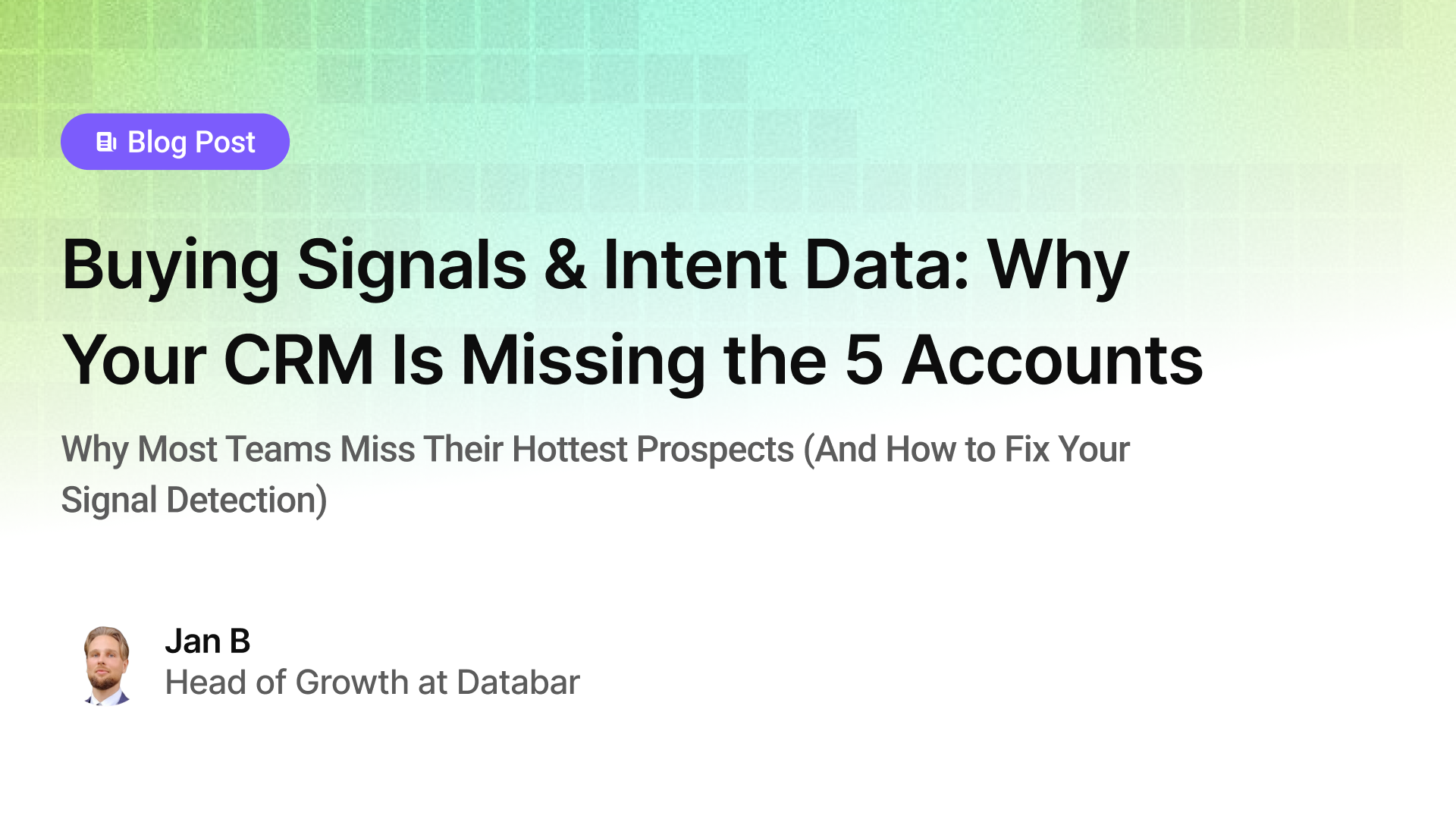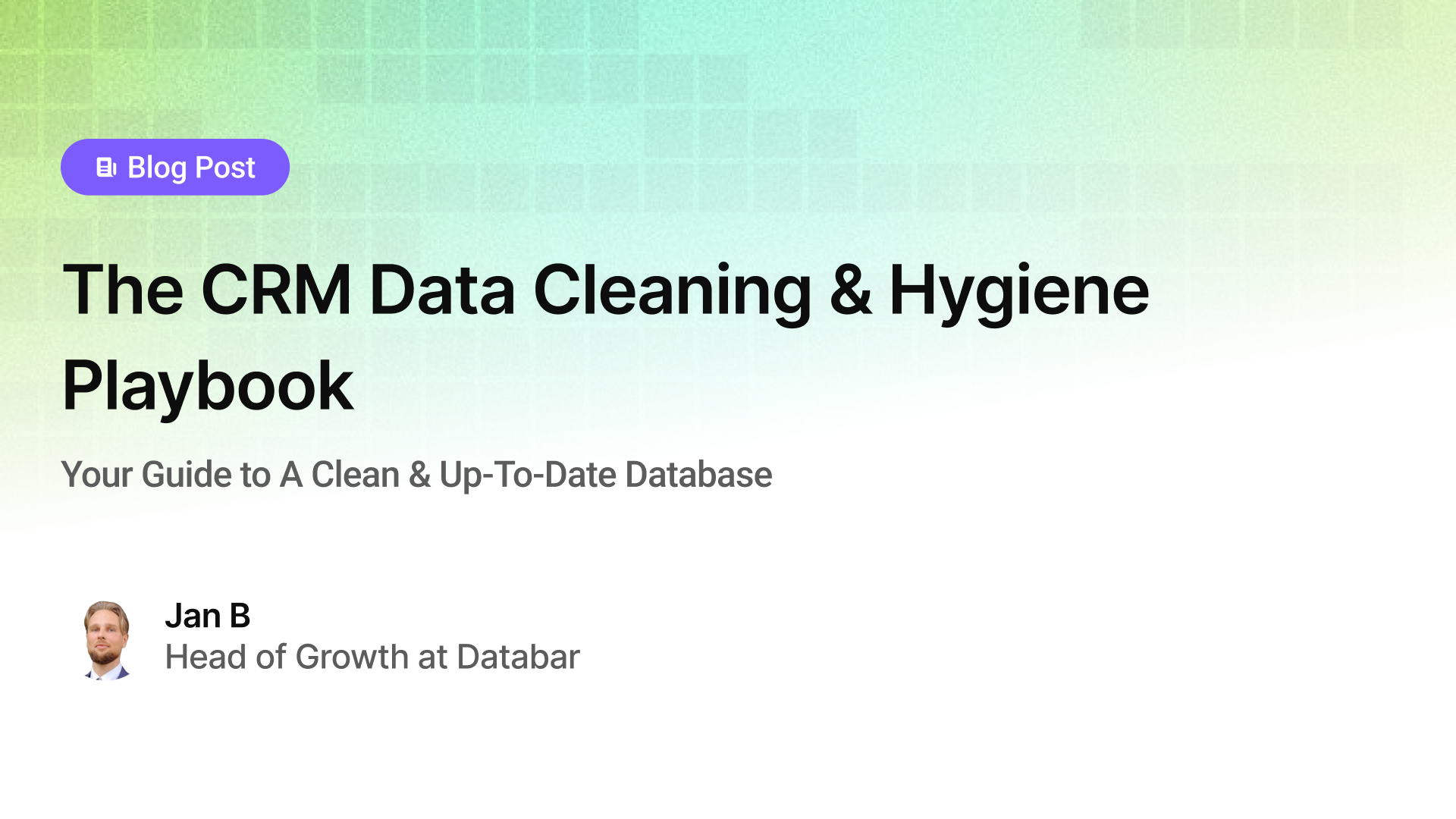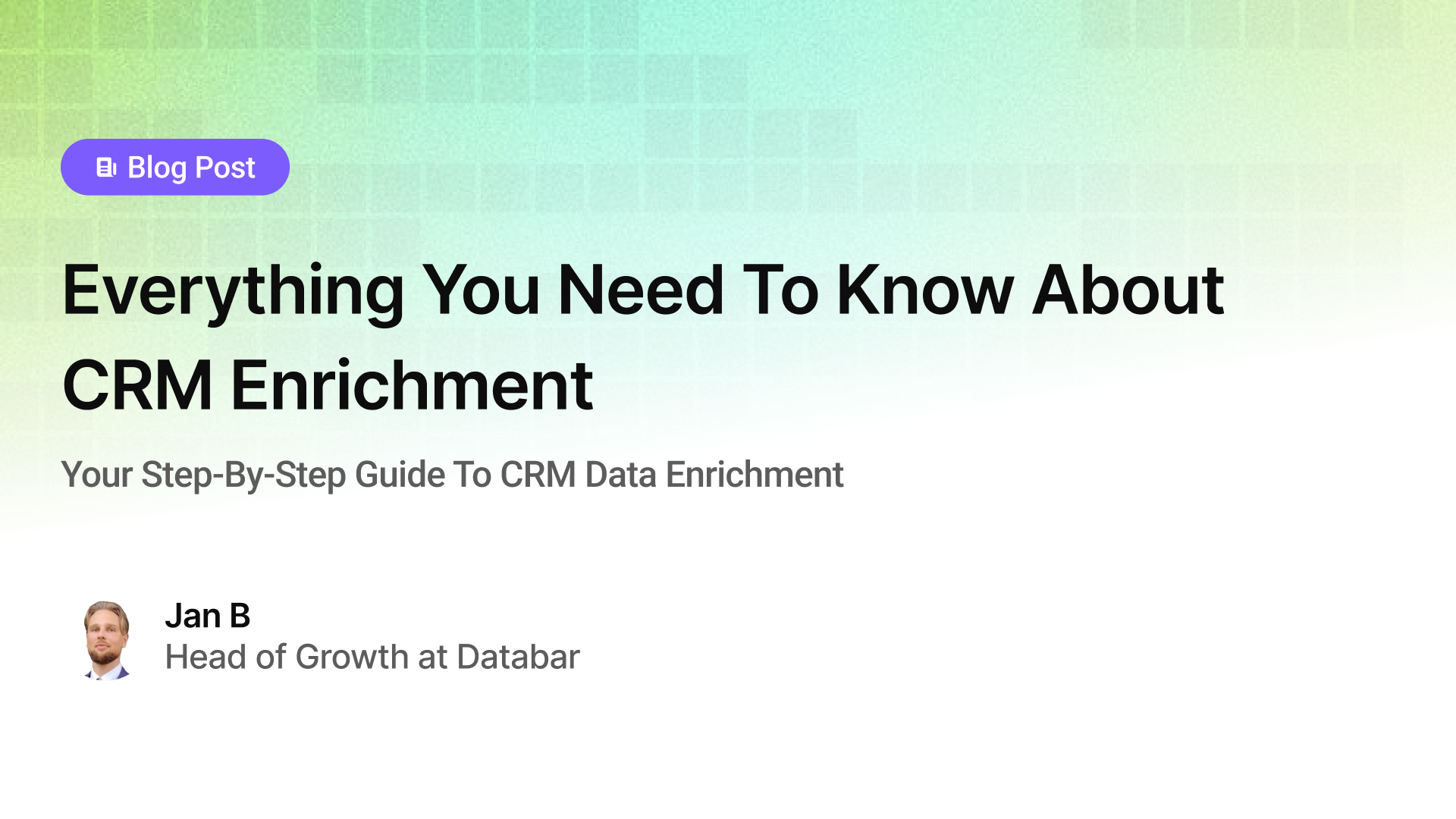Building a Sustainable AI-Powered GTM Engine
How to Build a Smarter, More Efficient GTM Engine with AI
Blogby JanMay 10, 2025

Companies that implement an effective AI-powered GTM strategy gain a significant edge in how they identify, engage, and convert prospects. The strategic integration of artificial intelligence into go-to-market functions creates more efficient processes and sustainable competitive advantages without requiring proportional increases in team size or budget.
This guide explores how to build and implement a truly sustainable AI-powered GTM strategy that delivers predictable revenue growth while optimizing your team's time and resources.
The Limitations of Traditional GTM Approaches
Before examining AI-driven solutions, it's important to understand why conventional go-to-market strategies increasingly fall short in current business environments:
Manual Research Bottlenecks
Traditional prospecting relies heavily on manual data gathering and enrichment, creating significant operational inefficiencies. Sales representatives typically spend 4-6 hours weekly researching basic prospect information—time that could be devoted to meaningful customer conversations and relationship building.
This manual approach creates diminishing returns as organizations attempt to scale, with research time increasing proportionally with target account volume. The resulting bottlenecks limit growth potential and create frustration across sales and marketing teams.
Personalization at Limited Scale
While personalized outreach consistently outperforms generic messaging, traditional approaches force an uncomfortable choice between quality and quantity. Without technological assistance, teams must either:
- Create highly personalized messages for a small number of accounts
- Send generic messages to a larger audience
- Compromise with superficial personalization that fails to engage recipients
This fundamental limitation has traditionally prevented organizations from achieving both relevance and scale simultaneously, constraining campaign effectiveness and conversion rates.
Fragmented Technology Ecosystems
The typical go-to-market technology stack has evolved as a collection of point solutions rather than an integrated system. Most organizations manage 7-10 disconnected tools spanning data enrichment, CRM, outreach automation, analytics, and channel management.
This fragmentation creates workflow inefficiencies, data synchronization challenges, and training burdens that reduce productivity and increase operational complexity. As new tools are added to address specific needs, the resulting "tech sprawl" often creates more problems than it solves.
Limited Optimization Capabilities
Traditional GTM approaches rely primarily on periodic manual reviews and adjustments rather than continuous data-driven optimization. This episodic improvement model means strategies often run sub-optimally for extended periods before being refined, resulting in missed opportunities and wasted resources.
The combination of these limitations creates a perfect storm where growth efforts become increasingly expensive and less effective as organizations attempt to scale—precisely when efficiency should be improving.
Core Components of an Effective AI-Powered GTM Strategy
Building a truly effective AI-powered GTM strategy requires focusing on four essential components:
1. Unified Data Enrichment Layer
The foundation of any effective GTM engine is comprehensive, accurate data. AI excels at gathering and organizing this information at scale.
Unlike traditional enrichment processes that rely on a single data provider, modern AI-powered GTM strategies use multiple data sources through a unified platform. This approach gives you:
- Access to 80+ data providers through a single interface
- 2-3x better data coverage compared to single-source solutions
- Automatic cross-verification to improve data accuracy
- Real-time enrichment that keeps information fresh
The best platforms use a "waterfall enrichment" approach, where they automatically check multiple providers until they find the data you need. This dramatically reduces the manual research burden on your team.
2. Intelligent Prospect Segmentation
Once you have rich prospect data, the next step is using AI to identify and prioritize your best opportunities.
Traditional segmentation relies on basic firmographic filters that miss crucial buying signals. AI-driven prospecting goes further by analyzing:
- Behavioral data showing product interest
- Technographic information revealing complementary tech
- Social engagement patterns indicating buying readiness
- Company growth signals that correlate with purchase intent
With these insights, you can create dynamic segments that continuously update based on new information. Your team always knows which prospects deserve immediate attention.
3. Personalization at Scale
The third pillar addresses the personalization challenge through AI tools that can craft relevant, contextual messages at scale.
Modern scalable sales intelligence systems can:
- Automatically pull relevant prospect information into outreach templates
- Generate personalized conversation starters based on recent company news
- Identify common connections or interests between rep and prospect
- Suggest optimal messaging based on similar successful outreach
This capability changes how teams approach personalization. Instead of choosing between high-volume generic outreach or low-volume personalized messages, you can maintain quality while scaling your efforts.
A director of demand gen at a cybersecurity firm shared that their team reduced message creation time by 65% while seeing a 28% increase in response rates after implementing AI personalization.
4. Continuous Optimization Loop
The final component that makes an AI-powered GTM strategy truly sustainable is its ability to continuously improve through feedback.
Traditional GTM approaches rely on periodic reviews and manual adjustments. An AI-powered system instead:
- Automatically tracks performance across all campaigns and channels
- Identifies successful messaging patterns to replicate
- Flags underperforming segments that need adjustment
- Recommends tactical improvements based on results
This creates a virtuous cycle where your GTM engine becomes more effective over time without requiring constant manual intervention. The system learns from its successes and failures.
How to Implement Your AI-Powered GTM Strategy
Now that we've covered the components, let's talk about implementation. Building a sustainable AI-powered GTM strategy requires a thoughtful approach:
Step 1: Assess Your Current GTM Process
Before adding AI to your go-to-market strategy, map your existing process to identify:
- Where your team spends the most time (usually data research and message creation)
- Which activities have the highest impact on conversions
- Current bottlenecks that limit scalability
- Metrics that indicate success for your specific business
This assessment creates a clear picture of where AI will deliver the biggest ROI. For most teams, prospecting and personalization are the primary pain points.
Step 2: Select an Integrated AI Platform
Rather than cobbling together multiple point solutions, look for a unified platform that:
- Connects to 80+ data providers through a single interface
- Offers automated enrichment without manual intervention
- Includes personalization capabilities powered by your enriched data
- Integrates with your existing CRM and outreach tools
The key here is reducing complexity. Each additional tool in your tech stack creates friction and potential points of failure. A senior GTM leader at a fintech company noted: "We went from nine separate tools to three after implementing our workflows inside Databar. The simplified workflow alone increased productivity by 25%."
Step 3: Define Your Enrichment Strategy
Effective AI-driven prospecting requires defining exactly what data you need. Create a list of essential data points, such as:
- Standard contact information (email, phone, social profiles)
- Company firmographics (size, industry, funding)
- Technographics (current tools used, tech stack)
- Buying intent signals (recent content engagement, hiring patterns)
- Relationship data (mutual connections, previous interactions)
With this clarity, you can configure your AI enrichment platform to specifically target the information that drives your sales process.
Step 4: Build Your Segmentation Framework
Next, develop a framework that uses your enriched data to segment prospects based on:
- Fit score (how well they match your ideal customer profile)
- Intent score (how actively they're showing buying signals)
- Relationship score (how connected they are to your organization)
- Opportunity score (special situations like new funding or expansion)
By combining these dimensions, you create a prioritization matrix that helps your team focus on the highest-potential opportunities first.
Step 5: Create Your Personalization Playbook
For sustainable growth automation, you need a personalization approach that balances quality and scale:
- Define your key personalization variables (e.g., industry challenges, tech stack, recent news)
- Create template frameworks that incorporate these variables
- Build fallback options when specific information isn't available
- Establish guidelines for human review and enhancement
This structured approach allows AI to handle the heavy lifting while preserving the human touches that make outreach effective.
Step 6: Implement Measurement and Optimization
The final step is establishing metrics to track performance and guide optimization:
- Response rates by segment and message type
- Conversion rates at each pipeline stage
- Time saved through automation
- Data accuracy and coverage metrics
- Return on investment calculations
Review these metrics regularly to identify areas for improvement and refine your approach. This creates the feedback loop that makes your AI-powered GTM strategy truly sustainable.
Common Pitfalls to Avoid
As you build your AI-powered GTM strategy, watch out for these common mistakes:
Over-Automating Human Touchpoints
While AI excels at data tasks, some interactions still require a human touch. Sales conversations, relationship building, and complex negotiations should be enhanced by AI, not replaced by it.
A common mistake is automating too much of the sales process, creating an impersonal experience that turns off prospects. One sales director shared: "We initially automated our entire follow-up sequence, but conversion rates dropped. After reintroducing strategic human touchpoints, engagement improved significantly."
Neglecting Data Quality Control
Even with AI enrichment, data quality requires attention. Implement regular quality checks and cleaning processes to maintain accuracy. Without these controls, your scalable sales intelligence system will gradually degrade as data becomes outdated or incorrect.
Focusing on Tools Over Strategy
The technology supporting your AI-powered GTM strategy matters, but don't let tool selection overshadow strategic thinking. I've seen companies invest heavily in AI platforms without clear use cases, resulting in sophisticated systems that don't address actual business needs. Always start with your go-to-market strategy, then identify how AI can enhance it. Technology should serve your strategic goals, not define them.
How are AI-Powered GTM Strategies evolving?
Looking ahead, several emerging trends will shape how companies build sustainable growth automation systems:
Predictive Opportunity Identification
Next-generation AI systems will move beyond reacting to signals to actively predicting which accounts are about to enter buying cycles. This capability will allow teams to engage prospects before they even begin formal vendor evaluations.
Hyper-Personalized Customer Journeys
As AI gets better at understanding prospect preferences, we'll see increasingly tailored customer journeys that adapt in real-time based on engagement and feedback. This will blur the line between marketing automation and personal conversations.
Autonomous Campaign Optimization
While today's systems can recommend improvements, future AI will autonomously test and implement optimizations across channels and messaging. This will create truly self-improving GTM engines that require minimal human management.
Companies that embrace these innovations while maintaining appropriate human oversight will create significant competitive advantages in their markets.
Building Your Sustainable AI-Powered GTM Engine Today
Creating an effective AI-powered GTM strategy doesn't happen overnight, but you can start making progress immediately:
- Begin with a focused use case—typically prospect enrichment or personalization
- Choose an integrated platform rather than point solutions
- Implement in phases, measuring results at each stage
- Gradually expand AI capabilities as you validate results
The most successful implementations I've seen start small, prove value quickly, and scale methodically. This approach builds confidence and ensures sustainable results.
The goal isn't just efficiency—it's creating a GTM engine that delivers predictable growth while becoming more effective over time. With the right approach to AI-driven prospecting and scalable sales intelligence, you can build a system that gives your team a lasting competitive advantage.
Conclusion: The Competitive Advantage of AI-Powered GTM
Building a sustainable AI-powered GTM strategy is essential for companies that want to scale efficiently and maintain quality customer interactions.
The organizations seeing the greatest success aren't just adopting AI tools—they're thoughtfully integrating them into cohesive systems that enhance human capabilities rather than replacing them. They're creating unified data environments that power intelligent segmentation and personalization, all while continuously improving through feedback loops.
The result is a go-to-market engine that gets more effective over time, creating a widening competitive advantage that's difficult for competitors to match. By starting your AI GTM journey today, you position your company to outperform the market not just this quarter, but for years to come.
Ready to improve your go-to-market approach with AI? Begin by assessing your current process, identifying your biggest pain points, and exploring integrated platforms that can address these challenges. The sooner you start, the faster you'll create your own sustainable growth advantage.
Related articles

Buying Signals & Intent Data: Why Your CRM Is Missing the 5 Accounts
Why Most Teams Miss Their Hottest Prospects (And How to Fix Your Signal Detection)
by Jan, October 06, 2025

Lead Scoring & Account Segmentation: Why Most CRMs Get This Backward (And How to Fix It)
How to build a system that tells your team who to call, when, and why
by Jan, October 06, 2025

The CRM Data Cleaning & Hygiene Playbook
Your Guide to A Clean & Up-To-Date Database
by Jan, October 04, 2025

Everything You Need To Know About CRM Enrichment
Your Step-By-Step Guide To CRM Data Enrichment
by Jan, October 03, 2025